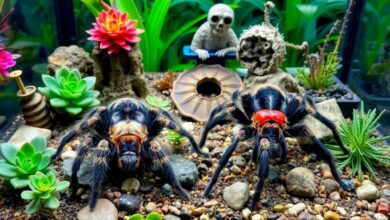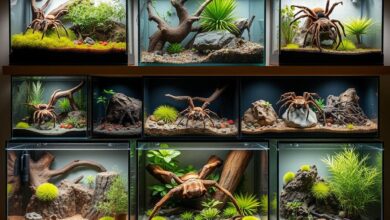Designing ideal terrariums for terrestrial species
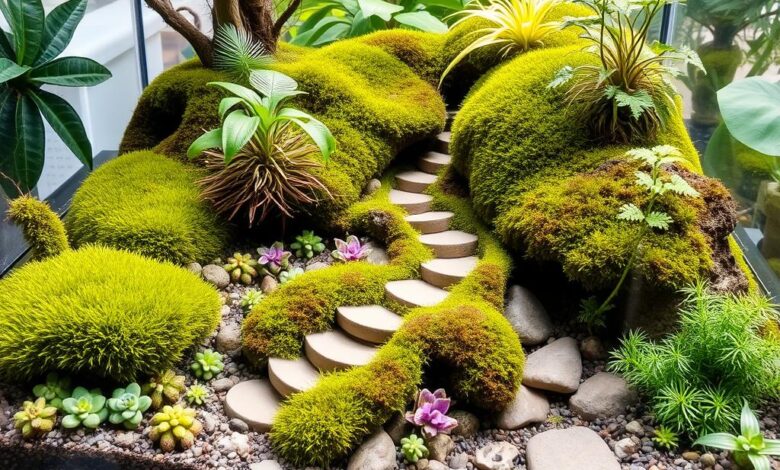
Terrariums are special spaces that keep a variety of land animals safe and happy. They are perfect for reptiles, amphibians, and invertebrates. To make the best terrarium, you need to think about size, substrate, lighting, and plants. These elements help create a mini world that feels natural and supports life.
Choosing the right terrarium size and shape is key. You also need the right substrate and a good drainage system. Adding places for your pets to hide, decorations, and the right plants makes the terrarium look great and supports life. This way, your terrarium becomes a mini world that your pets can call home.
Introduction to Terrariums for Terrestrial Species
A terrarium is a glass or acrylic box that holds plants and small animals like reptiles, amphibians, and invertebrates. These containers offer a stable home for plants and animals. They create a mini version of their natural world.
What is a Terrarium?
The word “terrarium” comes from “terra,” meaning earth. It’s a special home that mimics the earth’s natural settings. These habitats control things like temperature, humidity, and light. This makes a perfect place for the animals inside.
Benefits of Terrariums for Terrestrial Animals
- Controlled environment: Terrariums let you set the perfect temperature, humidity, and light for the animals.
- Naturalistic habitat: You can make terrariums look like the animals’ natural homes. They get the right hiding spots and things to play with.
- Observation opportunities: Watching terrariums is easy because they’re clear. You can see the animals and how they interact.
- Self-sustaining ecosystem: If you take care of it, a terrarium can take care of itself. Plants and small helpers keep it clean and balanced.
Creating a terrarium for terrestrial animals means giving them a home that’s full of life. It helps them stay healthy and happy.
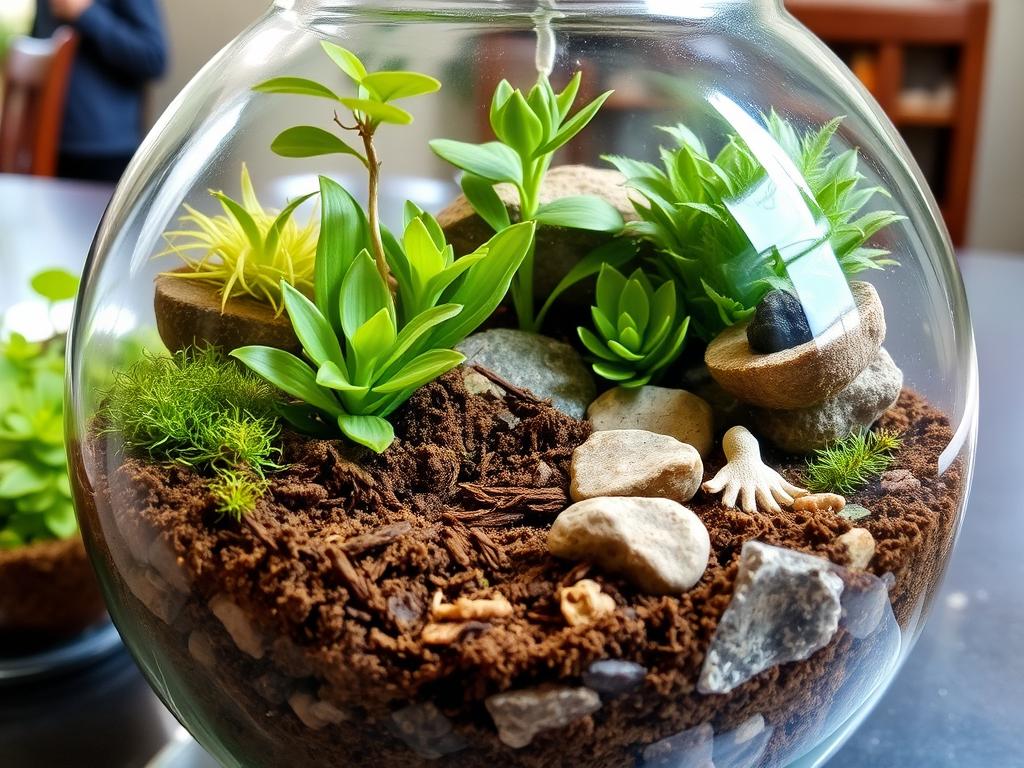
Planning Your Terrarium Design
When planning a terrarium for land animals, start by picking the right size and material for the enclosure. The terrarium should be big enough for the animals to move and act naturally. You can use glass, acrylic, or plastic for the terrarium, each with its own benefits.
Choosing the Right Enclosure
The size of the terrarium is key for the animals’ health. Think about how big the animals will get and how many you want to keep. Make sure they have enough room to move and behave naturally. Glass, acrylic, and plastic are common materials for terrariums, each with their own pros:
- Glass terrariums let you see everything clearly and are easy to clean, but they can be heavy and break easily.
- Acrylic terrariums are light, won’t shatter, and come in many shapes and sizes, but they might scratch more.
- Plastic terrariums are cheap, strong, and light, but they might not look as good as glass or acrylic.
Selecting Suitable Substrate and Drainage
The substrate in your terrarium is key for the animals’ health. You can use coco fiber, sphagnum moss, or a mix of soil and sand. Make sure the substrate drains well to stop water from building up and keep the right moisture levels.
| Substrate Option | Benefits |
|---|---|
| Coco Fiber | Keeps moisture in, lets air in, and is good for the planet. |
| Sphagnum Moss | Soaks up and holds water, keeps humidity right, and fights germs. |
| Soil and Sand Mixture | Gives a natural, food-rich spot for plants and digging animals. |
Good drainage stops water from pooling and keeps your terrarium’s animals healthy. Add a drainage layer at the bottom with gravel or expanded clay pebbles to let extra water drain through.
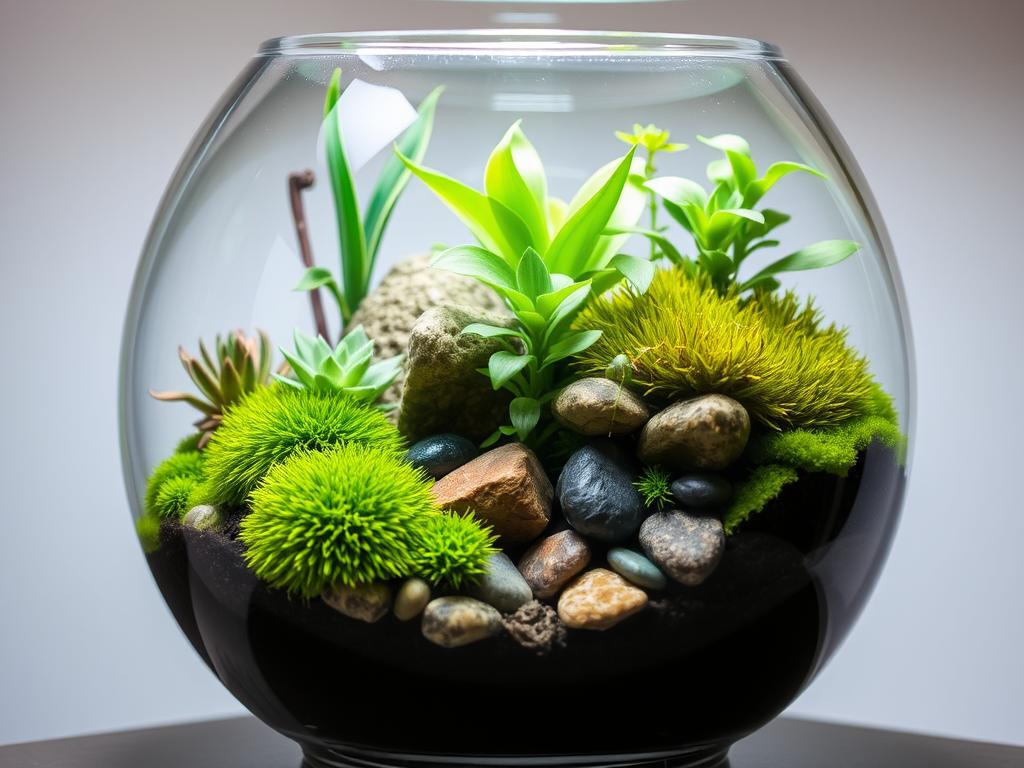
Creating a Naturalistic Environment
To make a great naturalistic terrarium design for your land animals, add things like driftwood, rocks, logs, and live plants. These items help make it feel like their real home. Adding different levels and hiding spots lets them act naturally, like digging, climbing, and sunning themselves.
When making a bioactive terrarium, think about what your animals need. For example, use sphagnum moss for frogs, toads, and snakes that like a lot of moisture. Aspen bedding is perfect for snakes and others that like to dig and hide. Coconut coir keeps moisture in and is good for chameleons, rainforest geckos, frogs, and toads.
- Incorporate driftwood, rocks, logs, and live plants to create a naturalistic environment.
- Provide multiple levels, nooks, and crevices to allow for natural behaviors like burrowing, climbing, and basking.
- Choose appropriate substrates based on the humidity and burrowing needs of your terrestrial species.
With the right terrarium decor, you can make a place that’s both beautiful and full of hiding spots for terrestrial animals. This lets your pets live their best lives and show off their natural ways.
Heating, Lighting, and Climate Control
Keeping the right terrarium heating, lighting, and humidity is key for your terrarium’s health. You can use under-tank heaters, overhead lamps, or ceramic heat emitters for heating. For lighting, choose from fluorescent, LED, or UVB bulbs. Adjust these settings to match the animals’ natural home needs.
It’s important to control the terrarium’s temperature for your animals’ health. Think about the species, its home, and what it needs for temperature. Make sure the terrarium stays within the best temperature range for your pets.
Lighting is also crucial for your terrarium’s health and behavior. Some animals need UVB, UVA, and visible light to live well. This light helps them feel like they’re in their natural setting.
Humidity is another key factor. Many animals like certain humidity levels. Use hygrometers, misting systems, and the right substrate to keep humidity just right.
By controlling temperature, lighting, and humidity, you can make a terrarium that feels like home for your animals. This helps them stay healthy, happy, and behave naturally.
Planting for Bioactive Terrariums
Adding live plants to a terrarium makes it more natural and active. When picking plants, choose ones that fit the lighting, humidity, and soil in your terrarium. Good choices include bromeliads, ferns, mosses, and succulents.
For a balanced environment, add beneficial cleanup crews like springtails and isopods. They help break down waste and keep the terrarium clean. These terrarium microfauna are key to the health of the plants and the terrarium itself.
Selecting Appropriate Plants
Think about these things when picking terrarium plants:
- Lighting needs: Pick plants that do well in your terrarium’s light.
- Humidity levels: Choose plants that like the moisture you can keep in the terrarium.
- Substrate compatibility: Make sure the plants will grow in the soil you’ve chosen.
Introducing Beneficial Cleanup Crews
To keep your terrarium healthy, add terrarium cleanup crew members like:
- Springtails: These small, jumping creatures break down organic waste and keep the soil healthy.
- Isopods: Known as “roly-polies,” isopods are great at decomposing and are part of the terrarium microfauna.
By picking the right plants and adding helpful terrarium cleanup crew members, you can have a thriving terrarium. It will be easy to take care of and will support itself.
Terrariums for Terrestrial Species
Terrariums are great for many terrestrial species, like reptiles and amphibians. It’s important to think about what they need and if they can live together.
Reptile Terrariums
Reptile terrariums are perfect for geckos, skinks, and small snakes. They need places to hide, different temperatures, and the right humidity. Make sure the terrarium is big enough and safe for all the animals living together.
Amphibian Terrariums
Amphibian terrariums are for frogs, salamanders, and newts. They have both wet and dry spots to mimic their natural homes. It’s key to pick the right soil, add hiding places, and keep the humidity and temperature just right.
Always check the needs of any animal you want in your terrarium. With careful planning, you can create a great home for many interesting creatures.
| Terrarium Type | Suitable Terrestrial Species | Key Considerations |
|---|---|---|
| Reptile Terrarium | Geckos, Skinks, Small Snakes | Temperature Gradients, Humidity Levels, Hiding Spots |
| Amphibian Terrarium | Frogs, Salamanders, Newts | Wet and Dry Areas, Substrate, Humidity Control |
Maintaining and Monitoring Your Terrarium
Keeping your terrarium in good shape is key to its success. You need to clean it regularly and check for pests. This keeps the environment healthy for your plants and animals.
It’s important to clean your terrarium often. Remove any waste or food that hasn’t been eaten. This stops mold and algae from growing.
Watch out for pests like mold or insects. If you find any, take steps to get rid of them quickly. This keeps your terrarium safe for its inhabitants.
Cleaning and Pest Control
Here are some tips to keep your terrarium clean:
- Regularly clean out any uneaten food, waste, or debris to prevent mold and algae.
- Wipe down the glass and decorations to keep your terrarium looking great.
- Look for pests like insects or mites and deal with them fast to stop them from spreading.
- Make sure to quarantine any new plants or animals before adding them to your terrarium.
- Keep the temperature, humidity, and lighting just right for a healthy environment.
By taking good care of your terrarium and watching it closely, you can keep it thriving. This makes sure your terrarium stays healthy and full of life.
Showcasing Your Terrarium Creation
Now that you’ve made your terrarium, it’s time to show it off! Terrarium display is a great way to inspire others and get them excited about the hobby. Photography is a top way to share your terrarium with the world.
Terrarium photography captures the beauty and details of your work. Take high-quality photos from various angles to show off your terrarium’s depth and design. Posting these on social media or in terrarium groups lets you share your terrarium with others. You can get feedback or find new inspiration.
Putting your terrarium in a spot where it gets a lot of light is a smart move. It makes your terrarium stand out and might get others interested in the hobby. By sharing your love for terrariums, you can motivate others to make their own unique spaces.
The fun of terrariums isn’t just in making them. It’s also in sharing your work with others. So, don’t hesitate to show off your terrarium. You might just inspire someone new to try it out.
Resources for Terrarium Enthusiasts
If you love terrariums, you’ll find many resources to help you learn and improve. There are books, online forums, and special shops full of information. They cover design, picking the right plants, and how to care for them.
Terrarium books are a great place to start. They cover everything from building your first terrarium to advanced techniques for creating realistic environments. These books are perfect for both beginners and experts, offering new ideas and inspiration.
Online are also a great way to connect with others who love terrariums. You can share your experiences and learn from others. These forums offer tips, advice, and insights on caring for different terrarium species. Talking with other enthusiasts keeps you updated and motivated in your terrarium journey.


